| Release List | Reviews | Price Search | Shop | Newsletter | Forum | DVD Giveaways | Blu-Ray/ HD DVD | Advertise |
| Reviews & Columns |
|
Reviews DVD TV on DVD Blu-ray International DVDs Theatrical Reviews by Studio Video Games Features Collector Series DVDs Easter Egg Database Interviews DVD Talk TV DVD Talk Radio Feature Articles Columns Anime Talk DVD Savant HD Talk Horror DVDs Silent DVD
|
DVD Talk Forum |
|
|
| Resources |
|
DVD Price Search Customer Service #'s RCE Info Links |
|
Columns
|
 |
Warner Bros. Pictures |
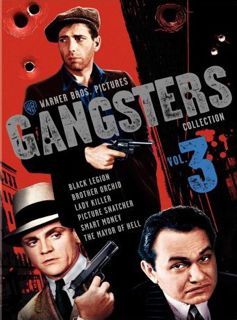
|
Warner Bros. Pictures Gangsters Collection Vol. 3 Smart Money, Picture Snatcher, The Mayor of Hell, Lady Killer, Black Legion, Brother Orchid Warner DVD 1931-1940 B&W 1:37 flat full frame Street Date March 25, 2008 59.98 the set, and individually at 19.98 Starring James Cagney, Humphrey Bogart, Edward G. Robinson Directed by Alfred E. Green, Roy Del Ruth, Archie Mayo and Lloyd Bacon |
Warner DVD's first two Gangsters collections, Volumes One and Two collect some of the best and most famous 'tough guy' pictures from the studio vaults. Warner Bros. Pictures Gangsters Collection Vol. 3 continues this trend with more 1930s tales of crime and punishment starring the studio's top racketeer talent, James Cagney, Humphrey Bogart and Edward G. Robinson. Viewers unfamiliar with the pictures will be intrigued by the studio's general sympathy for the hard times of the Depression, with its street-wise cardsharps and slick operators. Four of the films here are also from the Pre-code years, and exhibit a look-the-other-way attitude toward sex and wrongdoing in general. 1
Even better, Warners have performed full video restorations on these titles. We once saw the 77 year-old Smart Money in fuzzy 16mm prints, but this new transfer allows us to evaluate everything from the makeup used by James Cagney to the quality of the early sound recording. They play like new movies.
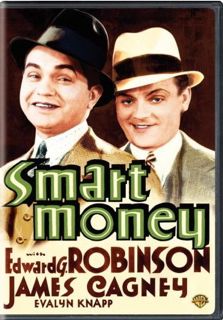
Written by the same team that concocted The Public Enemy, 1931's Smart Money is an immediate follow-up to Little Caesar intended to get the instant sensation Edward G. Robinson back on screens as quickly as possible. A plum role is also provided for James Cagney, here in his fourth or fifth outing; according to commentators Alain Silver and James Ursini, Cagney was filming Public Enemy practically at the same time.
Robinson is Nick Venizelos, known to his friends and customers as 'The Barber'. Nick has impressive gambling skills; he so dazzles everyone in tiny Irontown that his pals suggest he take their savings ($10,000) to New York, find a big card game and clean up. But Nick is immediately fleeced by a gang run by Sleepy Sam (Ralf Harold), who uses a decoy, Marie (Noel Francis) to bait the trap. Although broke, Nick returns and bluffs his way into a victorious rematch, using the same trick that Sam used. He walks away with all the cash -- and uses his newly arrived pal Jack (James Cagney) as a back-up triggerman to trump Sam's thugs. Nick tries more ambitious schemes, the biggest of which is a floating casino. The authorities can't connect him with it, even though the D.A. makes a failed attempt with an undercover agent (Evelyn Knapp). Knowing that his boss is highly susceptible to blondes, Jack is dismayed when Nick takes in Irene Graham (Margaret Livingston), a failed suicide. Unfortunately, the D.A. has a way of forcing Irene to help get the goods on Nick.
Smart Money is the only movie in which the two stars appear together. Robinson acts as if to the kleig lights born, while Cagney is definitely working on his camera presence in what is still a supporting role. What's more interesting about Kubec Glasmon and John Bright's script is its insistence on corruption as a universal state of affairs. Good-hearted small town boys Nick and Jack adjust effortlessly to the rackets once they decide that everything is rigged and honest jobs are not to be found. Jack suddenly appears with a .45 automatic, and Nick pulls off a bluff that could easily land him in the morgue. Sleepy Sam's weasels lie in wait for rubes that expect a fair card game, and each of the three dames that catches Nick's eye turns out to be wholly corruptible (even though Marie vows fidelity to Nick at the end). Worst of all, the law wants to curb Nick's gambling rackets only because it looks bad come election time. The D.A.'s technique to catch Nick is to plant fake evidence on him.
An odd vein of homosexual humor runs between Nick and Jack -- Jack's forever complaining when women are present, and Nick responds by making a crack about Irene leaving in a few days, so that "...you can be my sweetheart again, dearie." Jack ends up the victim of an unfortunate misunderstanding similar to that suffered by George Raft in Scarface. Even less PC is Nick's superstitious habit of rubbing hunchbacks' humps and black men's hair for good luck.
Charles Lane (26, but already playing older parts) is a hotel clerk, and a pre-stardom Boris Karloff has a small bit as Sport Williams, an obvious pimp character. Nick's soft spot for blondes is demonstrated early when he gives a hard luck case (Mae Madison) a hundred dollars, only for Sport to bet it in a wager a few seconds later. (spoiler) Nick does end up being punished for his sins, but he leaves for the big house cheerfully, almost like John Wayne at the end of Three Godfathers. Admiring associates and even one of his untrustworthy blondes give him a sincere sendoff.
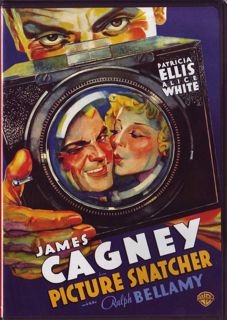
The next two James Cagney vehicles appear to have been thrown together with more haste than is usual. Lloyd Bacon's Picture Snatcher is a bit disorganized but shapes up as a wonderful Cagney showcase. Racketeer Danny Kean (Cagney) takes up an offer of a straight job by newspaperman Al McLean (Ralph Bellamy), made when Kean was in prison. Danny uses his criminal guile to get McLean's disreputable tabloid The Graphic Record coverage nobody else can. A fireman who lost his wife in a fire is holding reporters at bay with a shotgun, but Kean sneaks in and steals a family picture, scooping the competition. Danny is soon a hot reporter, phoning in the facts for literate rewrite men to transform into sensational copy.
Serious problems arise. Kean is attracted to pretty journalism major Pat Nolan (Patricia Ellis) but her father Casey (Robert Emmett O'Connor) happens to be the cop that put Kean in jail. In between getting Nolan promoted and busted, and fighting his old gangster pals, Danny learns the difference between cheap rag journalism and the real thing.
Danny Kean's biggest scoop is sneaking into Sing Sing to surreptitiously photograph an execution, a scene copied from reality. At the 1927 electrocution of Ruth Snyder and Judd Gray for conspiring to murder her husband, reporter Tom Howard strapped a camera to his ankle to get the forbidden photo. Danny Kean pulls off the exact same trick, turning a famous illegal act by the tabloid press into a Production Code-defying bit of movie sensationalism.
The rest of the movie is a fast-paced excuse for Cagney to be endearingly brash. The bigger the heel Cagney plays, the more we like him, and if Public Enemy made the bluenoses angry, it's clearly because Cagney makes thumbing one's nose at the law so damn attractive. The final scene sees Danny snapping pictures of a desperate criminal during a shootout with the police. He's no longer a criminal, but he's right in there with them.
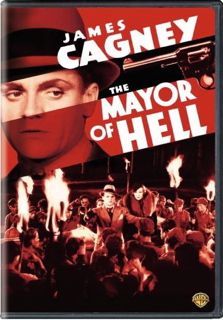
The Mayor of Hell
(1933) is a script that appears to have been pushed out of shape to accommodate Cagney.
DVD Savant has reviewed it separately at this link.

Released late in 1933, Lady Killer could have been written on a napkin, tossing in several ideas from different directions. It's a crime movie, a Hollywood exposé and a romantic comedy as needed, again proving that there's no such thing as too much James Cagney. Returning from Public Enemy is Mae Clarke, and instead of a grapefruit in the face she gets dragged around a hotel room by her hair -- all in good fun. The scattershot script will do anything for fun, as shown when the hero celebrates his Hollywood career by loosing a literal barrel of monkeys at a Beverly Hills garden party.
Cagney is Dan Quigley, an usher who gets fired for running a gambling sideline in a Chicago movie house. Just like Edward G. Robinson in Smart Money, he's snookered into a crooked card game by Myra Gale (Clarke) who drops purses in lobbies for gentlemen to retrieve. Quigley soon becomes the leader of the gang, which graduates to burglaries, using con games to target the homes of chosen millionaires. Feeling the heat, Dan quits and goes to California. He's hired as a film extra and quickly graduates to star status. But just when he's on top of the town and romancing star Lois Underwood (Margaret Lindsay), his old gang comes back to force him to cooperate in more burglaries.
The movie's midsection is a parody of Hollywood, with Cagney wearing out his rump playing an Indian on a mechanical horse, writing his own fan mail and roughing up a critic in a men's room. Several gags seem to have found their way into Singin' in the Rain, 20 years later. Dan Quigley arrives in 'sunny California' during a downpour and prances about the set of a costume drama in an overdone French dandy's outfit. He starts as an extra and climbs to star status by becoming a stunt player.
All director Roy Del Ruth need do is keep the action going; Lady Killer never has pretensions of importance, except to assure us that an Illinois felon is perfect movie star material. Bad girl Mae Clarke has a drawer filled with purses (hmmm...), but Margaret Lindsay (G-Men ) restores balance as a refined, sweet top star. Leslie Fenton and Douglass Dumbrille are Quigley's unrepentant crook associates.
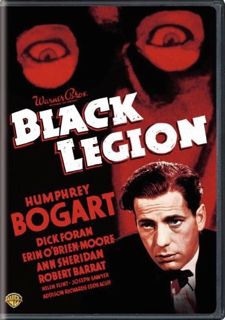
The mood swings to tragic social comment in 1936's Black Legion. It really belongs in a more politically minded collection, like 2005's Controversial Classics set, but I imagine that the WB DVD folks are beginning to run short on 30s Bogart pix.
Black Legion is definitely controversial, in the tradition of I Am a Fugitive from a Chain Gang. Humphrey Bogart plays Frank Taylor, an average-Joe machinist hoping for a promotion to shop foreman. Incensed when the nod goes to a Polish worker with less seniority, Joe Dombrowski (Henry Brandon), Frank becomes easy prey for fellow worker Cliff Summers (Joe Sawyer) and bigoted shopkeeper Osgood (Charles Halton), who recruit him for membership in a mysterious secret society. The Black Legion is dedicated to keeping the country pure by terrorizing immigrants and minorities who threaten the jobs of 'real' Americans. Donning capes and hoods, the Legion runs Dombrowski out of town, burning his cabin to the grown. Upped to foreman, Frank gets his own gun and costume as well as a new car, but his wife Ruth (Erin O'Brien-Moore) grows distant when he refuses to account for his activities on nights when the Legion strikes. Frank accidentally reveals the existence of the Legion to his best friend Ed Jackson (Dick Foran). The hooded vigilantes then turn their wrath on Ed.
Black Legion is a powerful film, especially considering when it was made. It's obvious that the Christian Legion is the Klu Klux Klan. Even though the targeting of 'lousy foreigners' has been documented, the Klan's real vigilante target is of course African-Americans. The story also takes pains to establish its generic Legion as a scam organized by profiteers, not reactionary religious fundamentalists. The Legion's ringleaders make money by selling revolvers and 'official' hood costumes, which means that the bigots are being exploited as well. There outta be a law!
The avoidance of the race issue puts the movie in the same category as the late-40s social protest movie Crossfire, which was compelled to substitute a Jew for its homosexual victim. Standing up for the rights of blacks was something that movies just didn't do in the middle of the 1930s. Yet both movies were successful in that they opened the door to public discussion about civil rights and civil liberties.
(Big spoiler)The emotional conclusion at the end of Black Legion provides a link between the outrage of I Am a Fugitive from a Chain Gang and the later, supposedly subversive movies of the early 50s, especially Cy Endfield's Try and Get Me! (The Sound of Fury.) Frank's wife stares in shock as he's hustled out of the courtroom to serve a long murder sentence, without so much as a pause for the customary regretful speech. The fade-out on her anguished face is almost as chilling as that of Paul Muni backing into the darkness in Chain Gang, hissing, "I Steal!" The finish also looks forward to the pathetic image in Try and Get Me!, when Kathleen Ryan babbles in disbelief as her husband Frank Lovejoy is arrested for kidnapping and murder in front of the neighbors. In all three films a decent man has become a public enemy to be shunned; the shared lesson is that America is infected with a social sickness and crumbling from within.
Bogart tries his best to be an ignorant everyman, but never looks quite innocent enough to fall for the Legion's spell. Erin O'Brien-Moore is fine as the traumatized wife, while Dick Foran is the same doofus we recall from the old Mummy movies. Making the best impression of all is a young Ann Sheridan, who in her 30th movie is finally progressing to better supporting roles. She makes us believe she's interested in Dick Foran, which is quite an accomplishment.
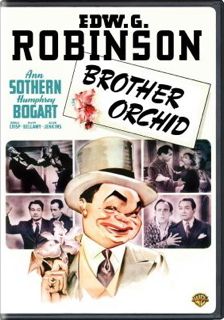
Brother Orchid was a childhood favorite, although its jokes no longer seem as hilarious as they once did. The gangster comedy presents the always-exceptional Edward G. Robinson as yet another Little Caesar type, who undergoes a change of heart after falling in with a different kind of 'gang', a group of gentle monks in a monastery. What the movie lacks in laughs, it makes up in sentiment.
Racketeer Little John Sarto (Robinson) decides to retire to Europe, leaving his crime organization to his humorless underling Jack Buck (Humphrey Bogart). Taken to the cleaners by continental snobs, Sarto returns, only to be given the heave-ho by his old buddies. His main squeeze Flo Adams (Ann Sothern) has remained semi-faithful, even though she's sort-of engaged to eccentric millionaire Clarence P. Fletcher (Ralph Bellamy, as yet another sweet-clueless gentleman cowboy). Flo, Clarence and faithful mug Willie 'The Knife' Corson (Allen Jenkins) are helping Sarto stage a comeback when he's captured by Buck's gunsels and taken for a ride. But Sarto escapes and hides out in a quiet monastery, where he slowly learns the meaning of entirely new concepts: trust and honesty.
Allen Jenkins is given some cute verbal schtick and Ralph Bellamy's helpful gang of western buddies are good for some slapstick fisticuffs, but most of Brother Orchid amounts to predictable gags at the expense of Edward G. Robinson's tough guy persona. His clueless racketeer is booted on his tail and otherwise humiliated, and never seems to know when he's playing a losing game. As a comedy, Orchid is even more uneven than the earlier A Slight Case of Murder, and lacks anything like that film's fall-down-funny beer tasting scene.
(spoiler)The film's big surprise is its slow build-up of the concept of human trust and integrity. Warners' 30s street cred was built on a cynical celebration of the Rat Race, and poor Sarto spends a lot of time getting kicked around by European swindlers and his own treacherous associates. Although the entire film plays in a juvenile chord, Robinson is so likeable that we delight when he realizes that the monks have chosen a superior lifestyle. We get a tingle when he renounces the false values of the rackets for a better way of living. Sarto's attempt to 'improve himself' in Europe was a flop, but he finds happiness cultivating Orchids in the monastery. It doesn't matter that the monks are almost cartoonish in their idealism. Seeing Robinson change gears warms our hearts.
The script doesn't treat Ann Sothern and Ralph Bellamy as well as it should, and poor Humphrey Bogart looks as though he's desperate to get away from movies like this. The monks are also a bit colorless, with Charles Brown, Cecil Kellaway and Donald Crisp pictured as perfect angels. When smiling Johnny Sarto comes back to the monastery for good, it's as if he's entering the gates of heaven. Seen in this light, Brother Orchid plays like an unconscious reality-twist tale by Ambrose Bierce or Luis Borges. It's easy to imagine an alternate scenario where Sarto doesn't escape being taken for a ride, but spends his last micro-second before death finding spiritual redemption in an alternate reality. In a way, Brother Orchid is the exact inverse of Point Blank.
The six features in the Warner Bros. Pictures Gangsters Collection Vol. 3 have been given the deluxe extras treatment. Each carries a 'Warner Night at the Movies' selection of trailers, newsreels, musical shorts (George Jessel, Cab Calloway) and cartoons. That's at least 25 minutes of warm-up entertainment before the WB shield heralds each main attraction. I don't know if any of these cartoons are rare: Big Man from the North (on Smart Money), Wake up the Gypsy in Me (on Picture Snatcher), The Organ Grinder (on The Mayor of Hell), The Shanty Where My Santy Claus Lives (on Lady Killer), Porky and Gabby (on Black Legion) and Busy Bakers & Slap Happy Pappy (on Brother Orchid). The discs also carry good commentaries by authors and critics who know their gangster history: Alain Silver, James Ursini, Greg Mank, Patricia King Hanson, Anthony Slide, Eric Lax and Alan L. Gansberg. Picture Snatcher has a trailer for a semi-remake called Escape from Crime, and both remakes of The Mayor of Hell are noted in trailer form: Crime School and Hell's Kitchen. Gangster fans interested only in one or two titles will also be pleased to know that all six are available individually.
On a scale of Excellent, Good, Fair, and Poor,
Warner Bros. Pictures Gangster Collection Vol. 3 rates:
Movie: all Excellent or Very Good
Video: all Excellent
Sound: all Excellent
Packaging: Six keep cases in card box
Reviewed: March 15, 2008
Footnote:
1. The Warner Bros. Pictures Gangsters Collection Vol. 2 is apparently a retitling of a set first released as Warner Bros. Tough Guys Collection.
Return
Reviews on the Savant main site have additional credits information and are more likely to be updated and annotated with reader input and graphics.
Review Staff | About DVD Talk | Newsletter Subscribe | Join DVD Talk Forum
Copyright © 1999-2007 DVDTalk.com All rights reserved | Privacy Policy | Terms of Use
|
| Release List | Reviews | Price Search | Shop | SUBSCRIBE | Forum | DVD Giveaways | Blu-Ray/ HD DVD | Advertise |





